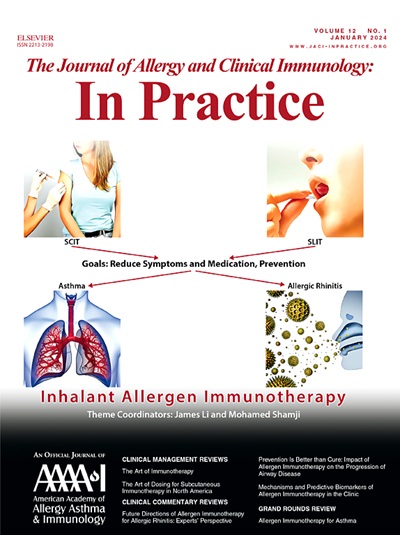Persistence, Severity, and Reactivity Thresholds in Fish-Allergic Patients Sensitized to Parvalbumin
IF 8.2
1区 医学
Q1 ALLERGY
Journal of Allergy and Clinical Immunology-In Practice
Pub Date : 2025-04-01
DOI:10.1016/j.jaip.2024.12.026
引用次数: 0
Abstract
Background
Fish allergy affects children and adults worldwide, and there are transient and persistent phenotypes.
Objective
We aimed to analyze persistence, severity, and reactivity thresholds in challenge-confirmed fish-allergic patients sensitized to parvalbumin.
Methods
Patients 12 to 65 years old reporting immediate reactions to fish, with fish skin prick test ≥5 mm and IgE to cod and carp β-parvalbumins ≥0.70 kUA/L, were recruited in 6 European centers. Except for the case with recent severe anaphylaxis, patients were eligible for a double-blind placebo-controlled food challenge with cod, followed, if negative, by an open food challenge. Severity of reported and elicited reactions was graded with the Food Allergy Severity Score, eliciting dose (ED) was calculated using interval-censoring survival analysis and probabilistic models, and factors associated with a positive challenge and severe reactions were analyzed by logistic regression.
Results
Of 42 patients fulfilling inclusion criteria, fish allergy was confirmed in 30 (71.4%) patients. The median fish allergy duration was 23 years. Although 70% of cases reported anaphylaxis with respiratory or cardiovascular involvement, food challenges resulted in oropharyngeal symptoms (34.7%) or mild systemic reactions (73.9%), with only 1 anaphylaxis with bronchospasm (4.3%). Male sex was associated with severe reactions (odds ratio: 5.44, 95% confidence interval: 1.04-28.53). ED10 for objective symptoms was 0.99 to 2.54 mg of protein. No correlation was found between severity and ED.
Conclusions
Adolescents and adults with persistent fish allergy linked to parvalbumin sensitization have experienced severe allergic reactions in real life and have a low threshold of reactivity. Our findings support the need for large-scale studies and new therapeutic options for these fish-allergic patients.
小鱼蛋白致敏的鱼类过敏患者的持久性、严重性和反应性阈值。
背景:鱼类过敏影响全世界的儿童和成人,有短暂和持续的表型。目的:分析小鱼蛋白致敏的鱼类过敏患者的持久性、严重程度和反应性阈值。方法:在欧洲6个研究中心招募年龄12-65岁、报告对鱼类有直接反应、鱼皮点刺试验≥5 mm、对鳕鱼和鲤鱼β-小蛋白IgE≥0.70 kUA/L的患者。除近期发生严重过敏反应的患者外,患者有资格接受双盲安慰剂对照的cod食物刺激,如果阴性,则进行开放食物刺激。报告和引发反应的严重程度用FASS分级,引发剂量(ED)使用间隔筛选生存分析和概率模型计算,并通过逻辑回归分析与阳性挑战和严重反应相关的因素。结果:在42例符合纳入标准的患者中,30例(71.4%)确诊为鱼类过敏。鱼类过敏的中位持续时间为23年。尽管70%的病例报告有呼吸道或心血管受累的过敏反应,但食物挑战导致口咽症状(34.7%)或轻度全身反应(73.9%),只有1例过敏反应伴有支气管痉挛(4.3%)。男性与严重反应相关(OR 5.44, 95%CI 1.04-28.53)。客观症状ED10范围为0.99 ~ 2.54 mg蛋白。结论:与小鱼蛋白致敏相关的持续性鱼类过敏的青少年和成人在现实生活中经历了严重的过敏反应,并且反应性阈值较低。我们的研究结果支持对这些鱼类过敏患者进行大规模研究和新的治疗选择的必要性。
本文章由计算机程序翻译,如有差异,请以英文原文为准。
求助全文
约1分钟内获得全文
求助全文
来源期刊

Journal of Allergy and Clinical Immunology-In Practice
ALLERGYIMMUNOLOGY-IMMUNOLOGY
CiteScore
11.10
自引率
9.60%
发文量
683
审稿时长
50 days
期刊介绍:
JACI: In Practice is an official publication of the American Academy of Allergy, Asthma & Immunology (AAAAI). It is a companion title to The Journal of Allergy and Clinical Immunology, and it aims to provide timely clinical papers, case reports, and management recommendations to clinical allergists and other physicians dealing with allergic and immunologic diseases in their practice. The mission of JACI: In Practice is to offer valid and impactful information that supports evidence-based clinical decisions in the diagnosis and management of asthma, allergies, immunologic conditions, and related diseases.
This journal publishes articles on various conditions treated by allergist-immunologists, including food allergy, respiratory disorders (such as asthma, rhinitis, nasal polyps, sinusitis, cough, ABPA, and hypersensitivity pneumonitis), drug allergy, insect sting allergy, anaphylaxis, dermatologic disorders (such as atopic dermatitis, contact dermatitis, urticaria, angioedema, and HAE), immunodeficiency, autoinflammatory syndromes, eosinophilic disorders, and mast cell disorders.
The focus of the journal is on providing cutting-edge clinical information that practitioners can use in their everyday practice or to acquire new knowledge and skills for the benefit of their patients. However, mechanistic or translational studies without immediate or near future clinical relevance, as well as animal studies, are not within the scope of the journal.
 求助内容:
求助内容: 应助结果提醒方式:
应助结果提醒方式:


